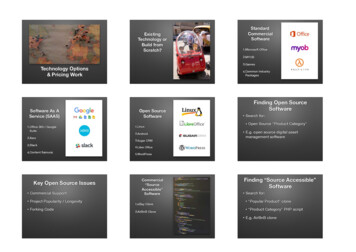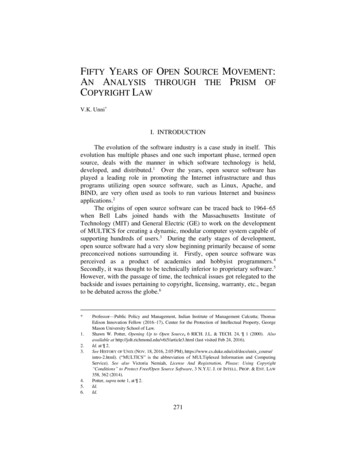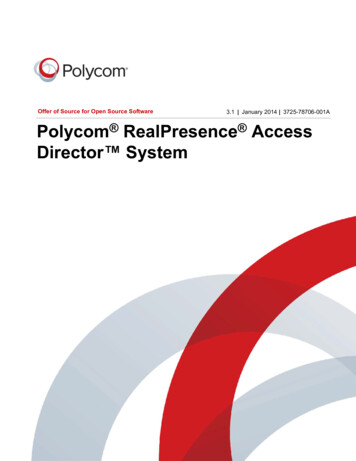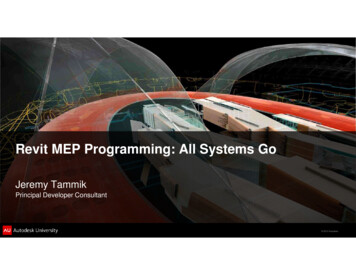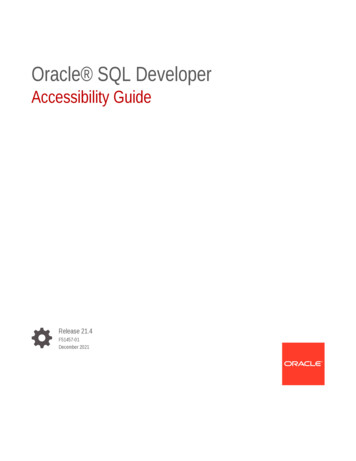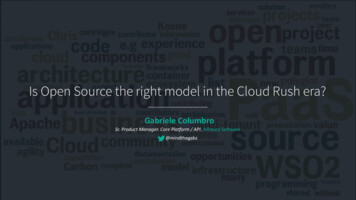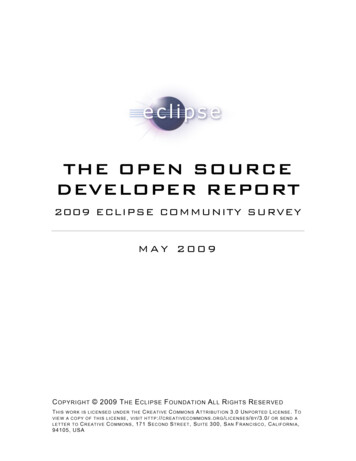
Transcription
THE OPEN SOURCEDEVELOPER REPORT2009 ECLIPSE COMMUNITY SURVEYMAY 2009C OPY RI GHT 2009 T HE E CLI PS E F OUNDAT ION A L L R I GHTS R E SE RVE DTHISWO R K I S LI C EN SE D U N D ER T H EC R E AT I VE C O MMO N S A T T R I BU T I O N 3.0 U N PO R T ED L I C EN S E . T OVI E W A C O PY O F T H I S LI C EN SE , VI SI T H T T P : // C R E AT I VEC O MMO N S . O R G / LI C EN S E S / BY /3.0 / O R S EN D ALET T E R T O C R EAT I V E C O M MO N S , 171 S EC O N D S T R E ET , S U I T E 300 , S AN F R AN C I S C O , C A LI F O R N I A ,94105, USA
TABLE OF CONTENTSEXECUTIVE SUMMARY3METHODOLOGY5DEMOGRAPHICS6THE DEVELOPER DESKTOP8LANGUAGE AND APPLICATION STYLE12THE DEPLOYMENT ENVIRONMENT15OPEN SOURCE PERCEPTIONS18ECLIPSE COMMUNITY PARTICIPATION20
E XE C UT I V E SU M M A R YEclipse is a large, vibrant, well established open source community with over 100 opensource projects, 1,000 committers, 170 member companies, thousands of companiesembedding Eclipse into products and applications and million of users. Eclipse beganas a Java IDE but has evolved into a much larger and more diverse open sourcecommunity. Eclipse has become a major destination for people involved in developingsoftware that includes open source software.In April 2009, the Eclipse Foundation undertook a survey of the Eclipse community tobetter understand:»»How people are using Eclipse and other open source software (OSS); andHow people participate in and perceive open source software.The purpose was to create a profile of how open source developers interact with thecommunity.A similar survey was conducted in August 2007 by IDC, in conjunction with The EclipseFoundation. The results of this survey, which can be found 6 cbsurvey.php, provide anopportunity to look at changes and trends over the last two years.Key Survey HighlightsAmong the highlights revealed by The Open Source Developer Report»Linux is gaining share on the desktop and server. Developers appear to beshifting away from Microsoft Windows to Linux and Mac OSX for their desktopdevelopment operating system. Linux is now the most common deploymentoperating system.»MySQL and Oracle are the dominant databases on which applications aredeployed, totaling 55%.»Subversion is the dominant Source Code Management system used bydevelopers, with 57.5%.The Open Sou rce Developer Repo rtC O PYR I G H T 2009 T H E E C LI P SE F O U N D AT I O N A LL R I G H T S R ES ER VED . T H I SU N D ER T H E C R E AT I VE C O MMO N S A T T R I BU T I O N 3.0 U N PO R T ED L I C EN SE .3/21WO R K I S LI C EN S ED
»»Organizations are progressing positively along the OSS Maturity Model: More organizations are allowing use of open source software andparticipation. 48.2% of respondents reported this for their company,compared to 37% in 2007. 15.6% state that their company has a business model reliant on OSStoday, versus only 10% two years ago.89.1% are satisfied or very satisfied with Eclipse.Complete survey results are available at http://eclipse.org/go/Survey 09.The Open Sou rce Developer Repo rtC O PYR I G H T 2009 T H E E C LI P SE F O U N D AT I O N A LL R I G H T S R ES ER VED . T H I SU N D ER T H E C R E AT I VE C O MMO N S A T T R I BU T I O N 3.0 U N PO R T ED L I C EN SE .4/21WO R K I S LI C EN S ED
M ET H O D OL O G YThe survey was promoted to individuals who visited the eclipse.org home page duringthe period of April 14 - May 15, 2009. On average, the eclipse.org home page receivesapproximately 1 million unique visitors per month. The survey was also promoted 1) onthe Eclipse Foundation newsgroup, 2) in a blog post that also appeared onPlanetEclipse, and 3) a number of times via Twitter.Heise.de, a leading German technology news site, published an article about the surveythat resulted in a larger proportion of respondents from Germany. However, an analysisof the results from German respondents does not show any significant difference in theoverall results.The survey was written in English and the eclipse.org website is only available inEnglish, so the representation is limited to English speaking users. The survey is biasedto Eclipse users. However, respondents did not need to be an Eclipse user to completethe survey. Due to the large penetration of Eclipse in the Java developer community, wealso believe the survey sample is a close approximation to the Java developercommunity.In total 1,481 individuals responded to the survey and 1,365 completed the entiresurvey. The survey can be found at: http://eclipse.org/go/Survey 09.In August 2007, IDC executed a survey in a similar manner on the eclipse.org website.We believe the sample of the two surveys is significantly similar to allow forcomparisons.The Open Sou rce Developer Repo rtC O PYR I G H T 2009 T H E E C LI P SE F O U N D AT I O N A LL R I G H T S R ES ER VED . T H I SU N D ER T H E C R E AT I VE C O MMO N S A T T R I BU T I O N 3.0 U N PO R T ED L I C EN SE .5/21WO R K I S LI C EN S ED
D E M O G RA P H I C SOver half of respondents identify themselves as programmers. Eclipse began as IDE forJava programmers, and though the ecosystem around it has been extended in severalways, Eclipse remains an important productivity tool for programmers. The fullbreakdown of survey respondents is as follows:Chart 1: Which of these titles best fits your role in the organization? (Choose one.)Half the respondents identified themselves as working in the high-tech or theprofessional services/consulting industry.Chart 2: Which of the following most closely describes your industry? (Choose one.)The Open Sou rce Developer Repo rtC O PYR I G H T 2009 T H E E C LI P SE F O U N D AT I O N A LL R I G H T S R ES ER VED . T H I SU N D ER T H E C R E AT I VE C O MMO N S A T T R I BU T I O N 3.0 U N PO R T ED L I C EN SE .6/21WO R K I S LI C EN S ED
The breakdown by size of the organization reflects a bias towards small to midsizebusinesses (SMBs).Chart 3: What is your best estimate of how many employees work at your organization?The Open Sou rce Developer Repo rtC O PYR I G H T 2009 T H E E C LI P SE F O U N D AT I O N A LL R I G H T S R ES ER VED . T H I SU N D ER T H E C R E AT I VE C O MMO N S A T T R I BU T I O N 3.0 U N PO R T ED L I C EN SE .7/21WO R K I S LI C EN S ED
T HE D EV E L OP E R D E SK T OPDevelopers appear to be shifting away from Microsoft Windows to Linux and Mac OSXfor their development operating system. 26.9% of respondents cite Linux was as primarydesktop operating system, representing a 7 percentage point increase from 2007.Though Windows is still the dominant development OS at 64%, it has decreased 10percentage points from 2007. The most popular Linux variant of choice amongdevelopers is Ubuntu, which accounts for over half of Linux respondents. Mac OSX hasincrease to 6.9% from 3.5% in 2007.Chart 4: What is your primary operating system for software development? (Choose one.)IDE PreferenceEclipse IDEs are the most popular primary development environments amongrespondents; Eclipse JDT (60%), Eclipse PHP Development Tools (12.6%) and C/C Developer Tools (6.3%). This is not surprising given the survey sample.The Open Sou rce Developer Repo rtC O PYR I G H T 2009 T H E E C LI P SE F O U N D AT I O N A LL R I G H T S R ES ER VED . T H I SU N D ER T H E C R E AT I VE C O MMO N S A T T R I BU T I O N 3.0 U N PO R T ED L I C EN SE .8/21WO R K I S LI C EN S ED
When we asked about secondary development IDEs, more than 80% report using asecondary IDE, which supports the conventional wisdom that developers use multipleIDEs. However, the distribution of secondary IDE is less concentrated; developers arechoosing a wider range of Eclipse-based and non Eclipse-based IDEs.Chart 5: What is your primary development environment (IDE)? What is your secondary IDE?(Choose one each.)Tools: Source Code, Change, and Build ManagementSource code management (SCM), change management (CMS) and build management(BM) are important tools for most developers. The survey asked respondents to selecttheir primary tool in each category.SCM: The dominant source code management system is Subversion, which is used by57.5% of respondents. CVS comes in at 20%, with the remaining spread out among awide variety of open source and commercial tools.For larger companies (more than 5,000 employees) the use of Subversion decreasessignificantly to 41.3%, while products like IBM Rational Clearcase increase from 3.8% to9.1% and Perforce from 2.7% to 6.2%.The Open Sou rce Developer Repo rtC O PYR I G H T 2009 T H E E C LI P SE F O U N D AT I O N A LL R I G H T S R ES ER VED . T H I SU N D ER T H E C R E AT I VE C O MMO N S A T T R I BU T I O N 3.0 U N PO R T ED L I C EN SE .9/21WO R K I S LI C EN S ED
All Companies5,000 EmployeesChart 6: What is your primary source code management system you typically use? (Choose one.)CMS: Atlassian JIRA and Bugzilla ranked as the most popular at about 17% each.However, 22.7% reported not using a CMS tool. Interestingly, TRAC (7.2%) andMANTIS (5.3%) accounted for more than half of the specified “Other” CMS tools, makingthem the third and fourth most popular CMS tools, respectively.Chart 7: What is the primary change management system you typically use? (Choose one each.)The Open Sou rce Developer Repo rtC O PYR I G H T 2009 T H E E C LI P SE F O U N D AT I O N A LL R I G H T S R ES ER VED . T H I SU N D ER T H E C R E AT I VE C O MMO N S A T T R I BU T I O N 3.0 U N PO R T ED L I C EN SE .10/21WO R K I S LI C EN S ED
Build and Release Management: Ant (33.4%) was the most popular build managementtool, followed by Maven (18%) and Hudson (9.1%) Again, more than 20% claimed theydid not use a build management tool.Chart 8: What is the primary build and release management product you typically use? (Chooseone each.)The Open Sou rce Developer Repo rtC O PYR I G H T 2009 T H E E C LI P SE F O U N D AT I O N A LL R I G H T S R ES ER VED . T H I SU N D ER T H E C R E AT I VE C O MMO N S A T T R I BU T I O N 3.0 U N PO R T ED L I C EN SE .11/21WO R K I S LI C EN S ED
LA N GU A G E A ND A P PL I CA T I O N ST Y LEJava is the dominant language being used by the community; 76.6% specify it is theirprimary development language. The types of applications respondents are developingtend to be server-centric (30.2%), web (24.7%), and desktop applications (23.4%).Chart 9: What is the primary type of software you are developing? (Choose one.)The survey then asked respondents in each of these three main categories to identifywhich software programs they use to develop their specific applications. Respondentswere asked to select all that applied, with an option to write in additional tools.The Open Sou rce Developer Repo rtC O PYR I G H T 2009 T H E E C LI P SE F O U N D AT I O N A LL R I G H T S R ES ER VED . T H I SU N D ER T H E C R E AT I VE C O MMO N S A T T R I BU T I O N 3.0 U N PO R T ED L I C EN SE .12/21WO R K I S LI C EN S ED
Server-Centric ApplicationsFor server-centric application development, respondents overwhelmingly rely onservlets, which was cited in 64.7% of the responses. For specific tooling, the preferredframework is Spring, which appears in half of the responses. EJBs also had a strongshowing with 38.3%. Examples of server-centric apps are J2EE apps, database apps,ERP, and CRM.Chart 10: What platforms are you using for creating server-centric software? (Select all thatapply.)The Open Sou rce Developer Repo rtC O PYR I G H T 2009 T H E E C LI P SE F O U N D AT I O N A LL R I G H T S R ES ER VED . T H I SU N D ER T H E C R E AT I VE C O MMO N S A T T R I BU T I O N 3.0 U N PO R T ED L I C EN SE .13/21WO R K I S LI C EN S ED
Web and Rich Internet ApplicationsWhen it comes to Web and rich Internet applications (RIAs), however, developers’choice of frameworks is widely distributed, demonstrating a degree of fragmentation inthis tools segment. The majority of responses (41.9%) were write-ins citing other toolssuch as Spring, JQuery, and even homegrown custom frameworks. Open source Ajaxframeworks are a popular second choice among developers, though unspecified.Flash/Flex, Dojo, and GWT also had strong showings.Chart 11: What frameworks are you using to create Rich Internet & Web Applications? (Select allthat apply.)Rich Desktop ApplicationsFor rich desktop applications, developers’ usage of Eclipse RCP (47.6%) and Swing(43.8%) were evenly split, which demonstrates a strong bias toward Java development.The Open Sou rce Developer Repo rtC O PYR I G H T 2009 T H E E C LI P SE F O U N D AT I O N A LL R I G H T S R ES ER VED . T H I SU N D ER T H E C R E AT I VE C O MMO N S A T T R I BU T I O N 3.0 U N PO R T ED L I C EN SE .14/21WO R K I S LI C EN S ED
T HE D EP L O Y M E N T E N V I RO N M E N TDevelopers need to deploy their applications into a production deployment environment.The survey asked about the primary operating system, database, and application serverthat were used to deploy their applications.Linux is taking an increase share of the deployment operating system environment.42.7% of the respondents selected Linux as their deployment environment; an increasefrom 37% in 2007. Ubuntu (12%) and Red Hat Enterprise Linux (10.2%) are the leadingLinux distros. Similar to the developer desktop, there has been a decrease in the use ofWindows as a deployment environment from 47% in 2007 to 40.5% in 2009. Also, thereappears to have been a decrease in the use of Sun Solaris/OpenSolaris as adeployment environment from 8% in 2007 to 5.2% in 2009.Chart 12: What is your primary operating system for software deployment? (Choose one.)The Open Sou rce Developer Repo rtC O PYR I G H T 2009 T H E E C LI P SE F O U N D AT I O N A LL R I G H T S R ES ER VED . T H I SU N D ER T H E C R E AT I VE C O MMO N S A T T R I BU T I O N 3.0 U N PO R T ED L I C EN SE .15/21WO R K I S LI C EN S ED
Primary DatabaseThe primary database used for deployment was evenly split between MySQL and Oracleat 27.7% and 27.3%, respectively. Given the recent Oracle acquisition of SunMicrosystems (and the MySQL portfolio), this represents an interesting consolidation ofdatabase providers. For large companies that have more than 5,000 employees, the useof MySQL significantly drops to 11.6%, while Oracle rises to 33.5% and IBM DB2increases to 10.7% from 6.2%.A further analysis of the respondents using Oracle and MySQL databases shows twodifferent profiles of users: 1) Oracles DB users tend to be building Java server basedapplications, and 2) MySQL users more RIA, LAMP style applications.Oracle DB users are:» Much more likely to be using Java as their primary development language(90.4% for Oracle DB users vs. 76.6% for all respondents)» Creating server-centric applications (51.8% for Oracle DB vs. 30.2% for all).» Much more likely to use an application server (only 6.5% of Oracle DB usersclaimed they did not use an application server vs. 25.3% for all)MySQL users are more likely to:» Use PHP as their primary language (17.4% of MySQL users say PHP is theirprimary language vs. 5.4% for all)» Create RIA/Web Applications (39.1% of MySQL users develop RIA/WebApplications vs. 24.7%)Chart 13: What is the primary database you typically use for deployed applications? (Chooseone.)The Open Sou rce Developer Repo rtC O PYR I G H T 2009 T H E E C LI P SE F O U N D AT I O N A LL R I G H T S R ES ER VED . T H I SU N D ER T H E C R E AT I VE C O MMO N S A T T R I BU T I O N 3.0 U N PO R T ED L I C EN SE .16/21WO R K I S LI C EN S ED
Primary Application ServerFinally, in the application server tier, the majority deploy on Apache Tomcat (34.8%),followed by JBoss (12.7%). For large companies (more than 5,000 employees) the useof Tomcat decreases to 26% and JBoss to 8.3 while IBM WebSphere increases to 12%and Oracle WebLogic nearly doubles to 7.9All Companies5,000 EmployeesChart 14: What is the primary application server you typically use for deployed applications?(Choose one.)The Open Sou rce Developer Repo rtC O PYR I G H T 2009 T H E E C LI P SE F O U N D AT I O N A LL R I G H T S R ES ER VED . T H I SU N D ER T H E C R E AT I VE C O MMO N S A T T R I BU T I O N 3.0 U N PO R T ED L I C EN SE .17/21WO R K I S LI C EN S ED
O PE N S O U RC E M AT U R I T YThe Eclipse Foundation uses an Open Source Maturity model to explain howorganizations perceive and participate in open source community. Overtime organizationmove from denial of open source, to usage, to modest contribution, to leading andchampion.Chart 15: The Open Source Maturity ModelOver the last two years, the survey results show that organizations are becoming moreopen to participating in open source software. When asked which best describes theirorganization’s approach to OSS, individuals affiliated with an organization showed adistinct maturing in their OSS participation.In 2007, 46% were allowed to use OSS but could not contribute back; now this grouphas decreased to only 27%. In contrast, 48.2% of respondents are now allowed by theircompany to use and contribute back to OSS communities—a significant increase from37% in 2007. How much OSS impacts an organization has changed as well. 15.6% ofrespondents report that their organization relies on OSS as a business model, anincrease from 10% in 2007.The Open Sou rce Developer Repo rtC O PYR I G H T 2009 T H E E C LI P SE F O U N D AT I O N A LL R I G H T S R ES ER VED . T H I SU N D ER T H E C R E AT I VE C O MMO N S A T T R I BU T I O N 3.0 U N PO R T ED L I C EN SE .18/21WO R K I S LI C EN S ED
Chart 16: What best describes your organization's policy towards the use of open sourcesoftware? (Choose one.)The Open Sou rce Developer Repo rtC O PYR I G H T 2009 T H E E C LI P SE F O U N D AT I O N A LL R I G H T S R ES ER VED . T H I SU N D ER T H E C R E AT I VE C O MMO N S A T T R I BU T I O N 3.0 U N PO R T ED L I C EN SE .19/21WO R K I S LI C EN S ED
EC L I P SE C O M MU N I T Y P AR T I C IP A T I O NThe survey also looked at the perception and participation within the Eclipse community.The most common way to participate is by opening a bug (24.6%) or answering anewsgroup post (15%). Unfortunately, a large population (67%) does not activelyparticipate in the community.The Eclipse community has evolved over the last 5 years, from a Java IDE to a morediverse open source community. The perception of Eclipse in the wider developercommunity is also changing. However, the most common perception is that Eclipse is adeveloper tools integration platform (27.9%) and an IDE for different languages (24.9%).Chart 17: Which statement best reflects your perception of Eclipse? (Choose one.)Overall, the Eclipse community is generally satisfied with Eclipse; 89.1% reportedsatisfied or very satisfied with Eclipse. Congratulations to everyone!The Open Sou rce Developer Repo rtC O PYR I G H T 2009 T H E E C LI P SE F O U N D AT I O N A LL R I G H T S R ES ER VED . T H I SU N D ER T H E C R E AT I VE C O MMO N S A T T R I BU T I O N 3.0 U N PO R T ED L I C EN SE .20/21WO R K I S LI C EN S ED
Chart 17: Overall, how satisfied are you with Eclipse? (Choose one.)The Open Sou rce Developer Repo rtC O PYR I G H T 2009 T H E E C LI P SE F O U N D AT I O N A LL R I G H T S R ES ER VED . T H I SU N D ER T H E C R E AT I VE C O MMO N S A T T R I BU T I O N 3.0 U N PO R T ED L I C EN SE .21/21WO R K I S LI C EN S ED
software that includes open source software. In April 2009, the Eclipse Foundation undertook a survey of the Eclipse community to better understand: » How people are using Eclipse and other open source software (OSS); and » How people participate in and perceive open source software. The purpose was to create a profile of how open source .



